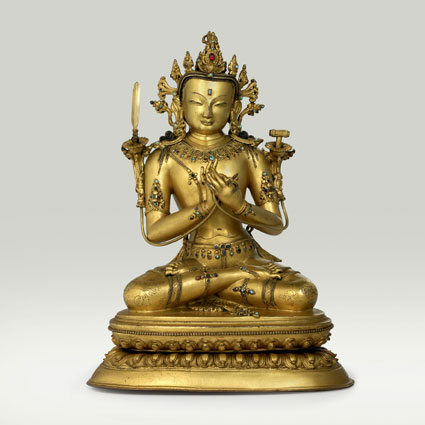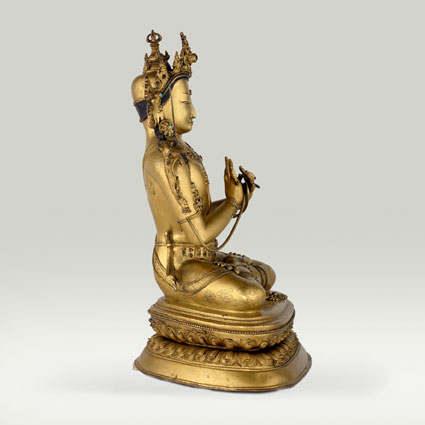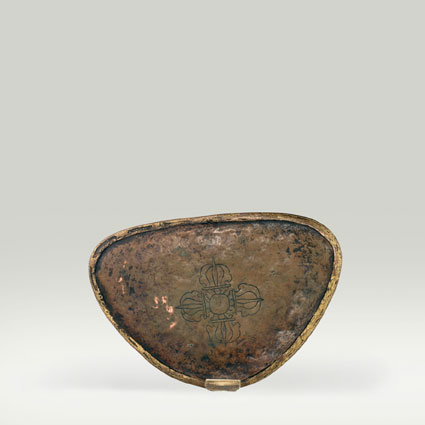ABS 076
Code: ABS 076
Country: Tibet (central)
Style: Nepalese School
Date: 1350 - 1400
Dimensions in cm WxHxD: 22.7 x 30.5 x 16.2
Materials: Gilt copper; inset with turquoise, coral, etc.
Hollow cast in two parts, with the lower section of the pedestal separate.
The lower edge of the crown is inlaid with "silver" and the sword at the right shoulder is cast in silver.
The ornamentation of the jewellery and the crown is worked with inset with turquoise, coral, lapis lazuli and one ruby in the centre of the crown.
The garment is decorated with engraved floral ornaments.
The hair is painted with a black pigment.
The bottom of the pedestal is sealed with a sheet of copper decorated with the visvavajra emblem.
Of all the metal alloys used for the casting of images in Tibet, it was the copper alloys which needed the most finishing work after the casting process. The jeweled ornaments of this image are especially fine worked. This Manjughosa was cast in Central Tibet latest by 1400.
Manjughosa (Tib. ’Jam pa’i dbyangs), a form of Manjusri (Tib. ’Jam dpal dbyangs), is seated in the diamond attitude (vajraparyaskasana) on a double lotus pedestal with an upper beaded border. The two hands each hold the stalk of a flower attached to the shoulders and form the “gesture of setting in motion the Wheel of the Law” (dharmacakra-pravartana-mudra). The two major attributes of Manjusri, the sword (khadga) and the manuscript (pustaka) of the Astasahasrika Prajnaparamita Sutra, are fixed to the flowers, which, according to the sadhanas of Manjusri should represent the blue lily (nilotpala). Manjusri is clad with a cloth tied around his waist with a belt. He wears princely ornaments, namely a helmet surmounted by a half vajra, a five fold crown, a pair of circular earrings, necklaces with attached pendants, bracelets at upper arms and wrists, finger rings, the “investiture with the sacred thread” (upavita) and ornaments at the anklets and the feet.
Of all the metal alloys used for the casting of images in Tibet, it was the copper alloys which needed the most finishing work after the casting process. The jewelled ornaments of this image are especially fine worked. This Manjughosa was cast in Central Tibet latest by 1400 AD.
The Sadhanamala (SM) contains seven descriptions of forms of Manjusri (Tib. ’Jam dpal dbyangs) displaying the “gesture of setting in motion the Wheel of the Law” (dharmacakra mudra). Beside being named in all seven sadhanasVadiraj (SM 46–49, 51–52, 54), he is additionally named as: Manjughosa (SM 46, 48, 51–52); Manjusri (SM 46–47, 49, 54); Dharmadhatu-Vagisvara (SM 46, 51); Manjuvajra (SM4 7, 54); Vadinatha (SM 47); Manjukumara (SM 47); Vadiraja (SM 48); Manjunatha (SM 48, 51); Manjuvara (SM 48, 54); Vagisvara (SM 52). In this publication, individual images of Manjusri displaying the dharmacakra mudra are labelled as Manjughosa (Tib. ’Jam pa’i dbyangs), regardless whether shown in the diamond attitude (vajraparyanka) or in the noble attitude(sattvaparyanka). When seated in the attitude of ease (vamardhaparyanka) on a lion he is named Vadisimha Manjusri (Tib. ’Jam dbyangs smra seng).
(From Wikipedia, the free encyclopedia)
Manjushree, also written Manjushri, is the bodhisattva of keen awareness in Buddhism. A disciple of the historical Buddha Shakyamuni, he represents wisdom, intelligence and realisation, and is one of the most popular Bodhisattvas following Avalokitesvara (Ch: Guan Yin).
Together with Shakyamuni and fellow disciple Samantabhadra he forms the Shakyamuni trinity (Jp: Sanzon Shaka). Manjusri is one of the Eight Wisdom Bodhisattvas and one of the Japanese Thirteen Buddhas. In Tibetan Buddhism he sometimes is depicted in a trinity with Avalokiteshvara and Vajrapani.
Manjusri is mentioned in many Mahayana sutras, particularly the Prajnaparamita Sutras. The Lotus Sutra assigns him a paradise called Vimala, which according to the Avatamsaka Sutra is located in the east. His consort in some traditions is Saraswati. He is also sometimes called Manjughosha.
Within Tibetan Buddhism, Manjushri is a tantric meditational deity or Yidam, and considered a fully enlightened Buddha.
Manjusri Mantra
Chanting the Manjusri Mantra "Om Ah Ra Pa Tsa Na Dhih" is believed to enhance wisdom and improve one's skills in debating, memory, writing, explaining etc. "Dhih" is the seed syllable of the mantra and is chanted with greater emphasis.
A male Bodhisattva, he is depicted wielding a flaming sword in his right hand, representing his realisation of wisdom which cuts through ignorance and wrong views. The scripture supported by the flower held in his left hand is the Prajnaparamita, representing his attainment of ultimate realisation and Enlightenment. Variations upon his traditional form as Manjusri include Guhya-Manjusri, Guhya-Manjuvajra, and Manjuswari, most of which are Tantric forms associated with Tibetan Buddhism. The two former appearances are generally accompanied by a shakti deity embracing the main figure, symbolising union of form and spirit, matter and energy.
Manchu
According to legend Nurhaci, a military leader of the Jurchen tribes and founder of what became the Chinese imperial Qing Dynasty, believed himself to be a reincarnation of Manjusri. He therefore is said to have renamed his tribe the Manchu.
Yamantaka
Yamantaka (meaning “terminator of Yama i.e. Death”) is seen as a wrathful manifestation of Manjushri, the buddha of wisdom. Yamāntaka (Tibetan: Shinjeshe Wylie: Gshin-rje-gshed) is a Mahayana Buddhist yidam or iṣṭadevata of the Highest Yoga Tantra class in Vajrayana, popular within the Geluk school of Tibetan Buddhism.
Role in Nepalese Mythology
According to Swayambhu Purana, the Kathmandu Valley was once a lake. It is believed that Manjushri saw a lotus flower in the center of the lake and cut a gorge at Chovar to allow the lake to drain. The place where the lotus flower settled became Swayambhunath Stupa and the valley thus became habitable.
The Newars of the Kathmandu Valley, who adhere to both Buddhism and Hinduism, revere him as the Bodhisattva of Wisdom.
Chandra, Lokesh, 1986. Buddhist Iconography of Tibet (CBIT). Rinsen Book Co.. P. 712: The Three Hundred Icons (sKu brnyan sum brgya) [2206–2503], No. 2286 (83): Abhisambodhi-Vairocana (Tib. rNam snang mngon byang) - References to the iconography of two-armed deities in samadhi mudra
de Mallmann, Marie-Thérèse, 1964. Étude iconographique sur Manjusri. Paris: École Française d’Extrème-Orient. Pp. 36-42, pl. VI: Dharmasankha-samadhi Manjusri - References to the iconography of two-armed deities in samadhi mudra
de Mallmann, Marie-Thérèse, 1975. Introduction à l'iconographie du tântrisme bouddhique. Paris: Adrien Mainsonneuve (Jean Maisonneuve successeur (1970). Pp. 94–96: Amitabha - References to the iconography of two-armed deities in samadhi mudra
Gordon, Antoinette K. , 1959. The Iconography of Tibetan Lamaism. Vermont: Charles E. Tutle, 2nd revised and enlarged edition. p. 68, illus. facing p. 66: Dharmasankha-samadhimanjusri - References to the iconography of two-armed deities in samadhi mudra
Lo Bue, Erberto and Ricca, Franco, 1990. Gyantse Revisited. Firenze: Casa Editrice Le Lettere & Torino: Cesmeo. P. 144 - References to the iconography of two-armed deities in samadhi mudra
Tucci, Giuseppe, 1941. Indo-Tibetica, Vol. IV, Gyantse ed i suoi Monasteri, Parte I. Roma: Reale Accademia d’Italia. P. 119 - References to the iconography of two-armed deities in samadhi mudra
von Schroeder, Ulrich, 2010. Buddhist Sculptures of the Alain Bordier Foundation. Hong Kong: Visual Dharma Publications, Ltd.. Pp. 52–53; plate 23A
von Schroeder, Ulrich, 2010. Buddhist Sculptures of the Alain Bordier Foundation. Hong Kong: Visual Dharma Publications, Ltd.. Pp. 34-35; plate 14A






